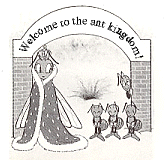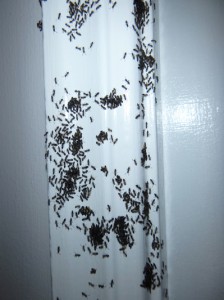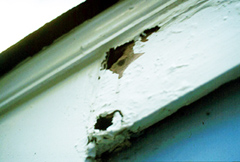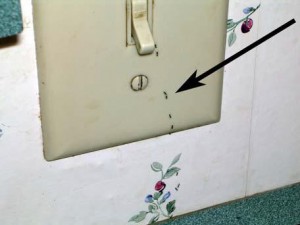Ant Extermination MN | Insect & Pest Removal
For better or for worse, insects are everywhere around us. As pets or pests, carriers of disease, or providers of protein, insects will always play an important role in our lives. Though we take them for granted, we all might find the world a more difficult place without our little insect companions. Without insects we would not have the quality of life we enjoy today. However, those little bitty bugs and insects can become a BIG problem when they start to invade our homes and businesses. The fact is, we share our planet with millions of insects, bugs, and wild animals. Some of them are even pretty darn cute, others extremely beneficial. Some animals that wander into your backyard are even fun and relaxing to watch. None the less, I don’t know about you, but most people have no desire to share their home with them. Scientists estimate that there are some 10 quintillion (10,000,000,000,000,000,000) individual insects alive. That’s 10 with 18 zeroes behind it–insects are alive on Earth at this very minute. That is nearly 1.5 Billion insects for every human being. From a population standpoint, insects rule our planet. Therefore, it is no big surprise that they try to get into our homes any way they can!
That’s A Lot Of Ants!
 Of all those insects, ants are one of the most populous living creatures on the planet with the largest biomass of any other animal (meaning if they all came together and got weighed they’d be heavier than even the combined weight of the human population!) Yikes! Of course, no one has actually counted them all or asked them to fill out little ant census forms, however, scientists have estimated that there are about 10 million, billion ants in the world, waiting for you to have a picnic. That’s more ants than there are mammals, reptiles, birds and amphibians combined. Another website gives an estimate of a quadrillion ants worldwide, more than the mileage to the nearest star. Here’s what a quadrillion looks like: 1,000,000,000,000,000. Ants are amazing creatures, with a complex, cooperative society that has enabled them to thrive all over the world no matter the changing conditions of the Earth. They have been here for over 140 million years, and therefore survived the extinction of the dinosaurs. They live pretty much everywhere on the Earth surface, and with around 20,000 species of ants, they can be considered to be one of Earth’s most successful species. Ants are also the number one pest problem in the country. Many of us have had the displeasure of having our homes infested with these tiny creatures; it doesn’t matter how many you kill either, they always come back for more. This fact alone shows what vast colonies they live in, and this is nothing compared to the size of unchecked colonies.
Of all those insects, ants are one of the most populous living creatures on the planet with the largest biomass of any other animal (meaning if they all came together and got weighed they’d be heavier than even the combined weight of the human population!) Yikes! Of course, no one has actually counted them all or asked them to fill out little ant census forms, however, scientists have estimated that there are about 10 million, billion ants in the world, waiting for you to have a picnic. That’s more ants than there are mammals, reptiles, birds and amphibians combined. Another website gives an estimate of a quadrillion ants worldwide, more than the mileage to the nearest star. Here’s what a quadrillion looks like: 1,000,000,000,000,000. Ants are amazing creatures, with a complex, cooperative society that has enabled them to thrive all over the world no matter the changing conditions of the Earth. They have been here for over 140 million years, and therefore survived the extinction of the dinosaurs. They live pretty much everywhere on the Earth surface, and with around 20,000 species of ants, they can be considered to be one of Earth’s most successful species. Ants are also the number one pest problem in the country. Many of us have had the displeasure of having our homes infested with these tiny creatures; it doesn’t matter how many you kill either, they always come back for more. This fact alone shows what vast colonies they live in, and this is nothing compared to the size of unchecked colonies.
Ant Prevention
 Simply spraying the foraging ants you see may bring temporary relief but it often fails to provide long-term, effective control. The workers you see are just a small portion of the overall colony; which often contains thousands of other worker ants, along with the egg-laying queen(s). The most effective ant control is accomplished by locating and destroying the nest(s). Inside and out! It is important to check carefully and thoroughly both indoors and outside to determine areas of ant activity, nest locations, and type of ant present. Indoors, follow ant trails to locate their entry point such as an electrical outlet or gap along a baseboards, door frames, or around a water pipe.
Simply spraying the foraging ants you see may bring temporary relief but it often fails to provide long-term, effective control. The workers you see are just a small portion of the overall colony; which often contains thousands of other worker ants, along with the egg-laying queen(s). The most effective ant control is accomplished by locating and destroying the nest(s). Inside and out! It is important to check carefully and thoroughly both indoors and outside to determine areas of ant activity, nest locations, and type of ant present. Indoors, follow ant trails to locate their entry point such as an electrical outlet or gap along a baseboards, door frames, or around a water pipe.  Outside, check the foundation, walkways, trees and shrubs, and in mulched areas for ant trails. Look for nests in mulch and vegetation next to the foundation. Check under potted plants, patio blocks, and stepping stones, and in piles of rocks, lumber, and firewood. Inspect the foundation to find possible ant entryways such as areas where pipes enter the building, foundation cracks, and around doors and windows. If swarmers were found indoors, then you could very easily have an indoor infestation, e.g., in a wall void, in the crawlspace or in the ceiling. In those situations, a careful inspection of the crawlspace may also be needed. Homeowners can help prevent ant infestations by taking a proactive approach in eliminating all entryways into the home.
Outside, check the foundation, walkways, trees and shrubs, and in mulched areas for ant trails. Look for nests in mulch and vegetation next to the foundation. Check under potted plants, patio blocks, and stepping stones, and in piles of rocks, lumber, and firewood. Inspect the foundation to find possible ant entryways such as areas where pipes enter the building, foundation cracks, and around doors and windows. If swarmers were found indoors, then you could very easily have an indoor infestation, e.g., in a wall void, in the crawlspace or in the ceiling. In those situations, a careful inspection of the crawlspace may also be needed. Homeowners can help prevent ant infestations by taking a proactive approach in eliminating all entryways into the home.
 Entry: Ants can enter through even the tiniest cracks, seeking water and sweet or greasy food substances in the kitchen pantry or storeroom areas.
Entry: Ants can enter through even the tiniest cracks, seeking water and sweet or greasy food substances in the kitchen pantry or storeroom areas.- Scent trails: Ants leave an invisible chemical trail which contains pheromones for others to follow once they locate the food source.
- Nest locations: They can nest about anywhere in and around your house; in lawns, walls, stumps, even under foundations.
- Colony size: Can number up to 300,000 to 500,000 and whole colonies can uproot and relocate quickly when threatened.
- Colony Lifetime: A colony can live a relatively long lifetime. Worker ants may live seven years and the queen may live as long as 15 years.
- Do-it-yourself ineffectiveness: Most do-it-yourself ant control approaches only kill the ants you see. Some truly effective treatments can penetrate and destroy nests to help prevent these pests from returning. Also, home remedies don’t account for the fact that different kinds of ant infestations require different treatments.
MN Ant Exterminator
Given the fact that ants have conquered land, sea and air, and have even outlived the dinosaurs… it’s a pretty safe bet they can survive a Minnesota winter! Maybe in your house! So, if you are having difficulty controlling an ant problem in your home, contact a Minnesota pest control exterminator. The sooner, the better! What you may not realize is that the ones you is usually just the tip of the iceberg compared to the number you may actually have.




